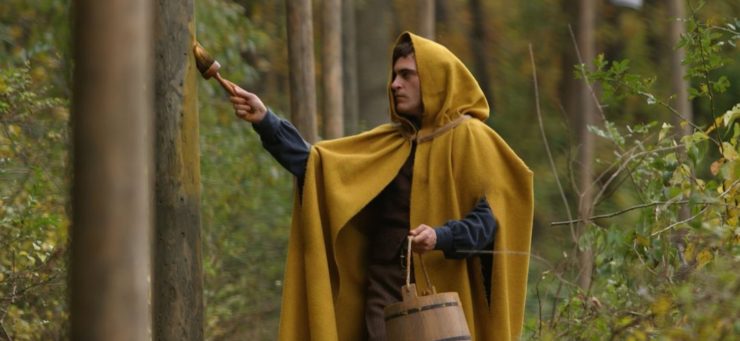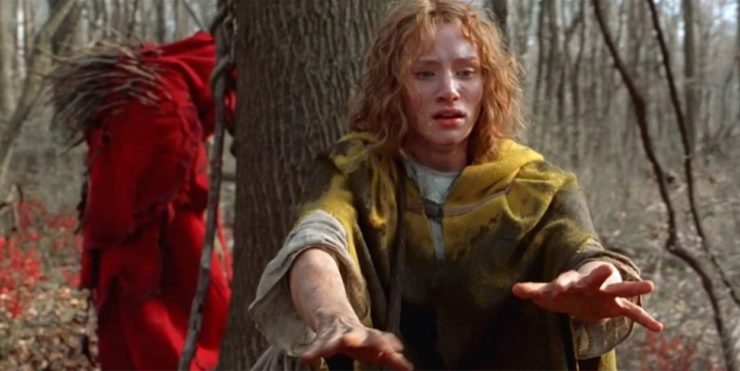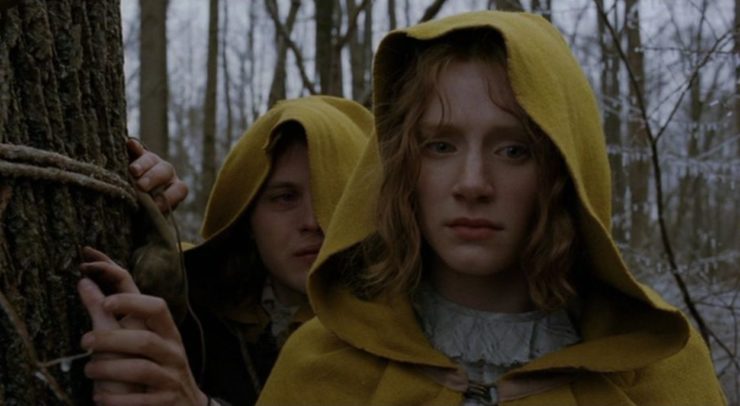Amid all the recent drama surrounding Don’t Worry Darling, Olivia Wilde’s sophomore film that relies on a plot device that the Turkey City Lexicon calls “The Jar of Tang,” there has been a flurry of comparisons to other films: The Truman Show, Pleasantville, Never Let Me Go, and M. Night Shyamalan’s 2004 folk horror film, The Village.
Like Don’t Worry Darling, The Village featured a stacked cast and a winning director paired with oodles of atmosphere, but still suffered the wrath of its critics. Roger Ebert gave it one star, calling it “a colossal miscalculation, a movie based on a premise that cannot support it, a premise so transparent it would be laughable were the movie not so deadly solemn.” This is a reasonable critique: the premise of The Village pops like a soap bubble if you so much as breathe on it. It is, in fact, as absurd in its worldbuilding as the series its title alludes to: 1967’s The Prisoner. In The Prisoner, a secret agent is abducted to an idyllic small town cut off from the rest of the world. It’s a colourful place where anything anyone could ever want is in abundance, not unlike the setting of The Good Place (2016). And like the Good Place, it is a bad place. In between interrogations, the secret agent’s captors refer to it as “The Village.”
The Village takes place in an isolated community somewhere in America. The houses are made of stone and heated by flame. Roger Deakins lights the film with dying autumn sun, flickering candles, and blazing lanterns. We have no idea if the story takes place before the arrival of electricity, or if the community has eschewed it for religious or environmental reasons. What we do know is that everyone is White, and everyone wears natural fibres like homespun cotton and wool, and the girls dress modestly in long sleeves and long skirts. (Always skirts. Never trousers.) When one character requests her father’s blessing to pursue her beloved, her father inquires why “the boy” is not at her side. That her beloved might not be a boy is never entertained as a possibility. Residents refer to “the towns” beyond the surrounding forest as “evil.”
And occasionally, huge red-cloaked figures with claws for hands come in, and leave behind the bodies of skinned animals. The villagers refer to them as Those We Don’t Speak Of, and seemingly every tradition they maintain is intended to uphold “the truce” between the two groups. Boys man the watchtower every night. (Always boys. Never girls.) Even the colour of the cloaks is forbidden: a sprig of rebellious red flowers must be buried, on sight. “There are secrets in every corner of this village,” Joaquin Phoenix’s character tells his mother, played by a surprisingly tender Sigourney Weaver.
Maybe this is the past, thinks the viewer. Maybe they’re Amish. Maybe this is Shyamalan’s exploration of Pennsylvania Dutch life, after years of filming in Philadelphia. Maybe it’s a cult. Maybe this place is Brigadoon. Maybe it’s Summerisle. Maybe it’s the Matrix.
It’s a lie.

Near the end of the film, we learn that the village is at the centre of a nature preserve funded by old family money, a legacy of the town elder played by William Hurt, who years ago invited the members of his bereavement support group to listen to “an idea” of his. The “idea” is as old as the idea of America itself: the intrusion of White settlers on the natural world, and the exclusion of all others who aren’t in on the joke. In this context, all the talk of “the bad colour” takes on a new meaning: Those We Don’t Speak Of are red, a colour which, until it became synonymous with how a state voted, was short for threats to the (White) American way of life posed by either its original Indigenous inhabitants—who were forcibly displaced or killed—or Communist ideas seeping into the cultural foundations upon which American individualism, competition, and unfettered growth were built.
Shyamalan, who knew exactly what film he had written and directed, makes his signature Hitchcockian cameo as the only Brown person in the film, the camera briefly focusing on his reflection in a plate of glass. The film’s gaze can’t even look at him directly. An early draft of the script leaked in 2003, and its final line of dialogue is spoken by the truck driver who helps Bryce Dallas Howard’s character obtain the medicines she has spent her life being denied. “Crazy-fucking-white people,” he says, and drives away.
The film was released in 2004, in that delicate slice of decade between the fall of the towers and the fall of the market. It was before Facebook or Meta, before Pinterest, before Twitter, before even Reddit, before a Russian company bought LiveJournal, when the internet was simply Something Awful, when phones flipped open and doors slammed shut on AOL. It was when Spider-Man was Tobey Maguire and Daredevil was Ben Affleck. It was when Netflix sent customers DVDs by mail, three at a time, and the next films in the customer’s queue didn’t arrive until the previous ones were returned. The people who first saw The Village saw it in theatres, and they had no digital town square within which to reveal the twist to a growing horde of strangers. “Word of mouth” was actually spoken out loud.
Viewers complained that The Village was “not really a horror film,” because it contained no supernatural or paranormal elements. This complaint conveniently ignores the fact that the definitive folk horror film of the twentieth century, 1973’s The Wicker Man, has no supernatural or paranormal elements either. There are no ghosts or goblins in The Wicker Man: only people, people so righteous in their faith that burning a virgin policeman (and several bleating animals) alive seems the only solution to their problems.
The ultimate horror of The Village is much the same. The village is a cross between a LARP and a Revolutionary War re-enactment: it is a theme park these people chose to live in, where they would never have to deal with anyone different, and where, as Hurt’s character says, “innocence” can be protected. It’s not a revolution. It’s just a homeowners’ association. A group of otherwise-reasonable adults chose to live on a nature preserve financed by private money, cosplaying a nostalgic brand of early Americana that never really happened, all so they might raise their children without the benefit of electricity, indoor plumbing, painkillers, abortion, journalism, antibiotics, media, or vaccines.
“My brother was slain in the towns. The rest of my family died here,” Brendan Gleeson’s character says. The film opens with him burying his last child. The plot hinges on Bryce Dallas Howard’s character going to “the towns” for “medicines,” that would be unavailable otherwise. One character’s sudden childhood blindness might be the sign of a life-threatening illness, but it’s never addressed. Another character’s developmental differences, which cause him visible frustration, could be explored, but aren’t. This community deliberately brought itself backward to a past where every infection, every pregnancy, every bad tooth or bad fall, might result in suffering and death.
This was the utopia they fought for. This was their escape hatch. This was their answer to the problems of contemporary life: to abandon it entirely for the ultimate gated community, a well-curated, aesthetically-consistent American experience of homogeneity where everyone dresses the same, eats the same, believes the same, fucks the same, dies the same.

Critical re-appraisals of the film have viewed it through a variety of topical lenses. For Emily St James it was about the Iraq War. For Chris Evangelista, it was about grief. For Carlos Morales, it was a love story. And it is indeed that. Most critics agree that the film’s most powerful image is of Bryce Dallas Howard holding out her hand in the presence of danger, waiting for Joaquin Phoenix to take it. (For that is love: blindly holding out a trembling hand in the dark, not knowing if it will be kissed or bitten.) It is a capital-R Romantic film, in which William Hurt says, “The world moves for love. It kneels before it in awe.”
But in addition to being a film about romantic love, it is also a horror film about smothering parental love: the kind of love that insists keeping one’s children away from public education, advancements in medicine, or other experiences of life is somehow a measure of affection. It’s about the performance of community and family, about how social bonds depend on a group inhabiting the same fictional narrative. It’s a folk horror film in which the folk are the monsters, quite literally: Those We Do Not Speak Of are the town elders dressed up in disguise. The monsters that parents warn their children about are, in fact, themselves.
Buy the Book


Even Though I Knew the End
For a film about people lacking access to the Internet, The Village is remarkably prescient about the Internet. Written at a time before platforms devoured chat rooms and bulletin boards and blogs, when the Internet was a coral reef and not a phish farm, it accurately anticipated the hardening of social and cultural borders brought about by algorithms that showed people “more like this,” and nothing else. It anticipated the retreat of lively conversation into curated “circles” or “groups,” the transition from free radio waves to subscribed podcasts, the shift from open publications to closed newsletters. It anticipated, perhaps better than any other film before or since, the hermetic sealing of the commons: public parks displaced by private shopping malls, public libraries competing with Amazon, public transit stalled by rideshares. It revealed the lie at the core of every trad-wife Pinterest spread, years before Pinterest taught Americans to eat everything from Mason jars. It accurately foresaw the tidy subdivision of an entire cultural landscape into a series of media fiefdoms in which how you feel about a woman swinging a laser sword is a reliable indicator of how you vote.
In its prescience about the Internet, The Village also saw the end of the Internet as we now know it. The splintering of social media platforms into market demographics (Facebook for Boomers, Twitter for Millennials, TikTok for Gen Z, various crypto Discords for ex-boyfriends of every age) has reduced what was once a dense cosmopolis into a series of ever-smaller towns. Villages, if you will. Small Slacks, miniature Mastodons, even tiny Teams and zygotic Zooms. The online spaces in which we once met people from all walks of life are now walled gardens at the level of culture, software, and mathematics: we are shown only our mirrors, and the sensation is akin to being trapped in a funhouse after too much cotton candy. With the possible end of Twitter on the horizon, the public square—and indeed, the idea of a public space at all—might finally have perished, replaced by, as Bruce Sterling himself called it, islands in the net.
The Village isn’t the only horror film to speculate accurately about the social impact of the Internet. In the late 1990s, Japanese horror films like Ringu, One Missed Call, Pulse, Cure, and The Suicide Club all spoke to a deep (and some might say valid) anxiety about what would happen to humanity when everyone suddenly had access to the innermost thoughts and feelings of everyone else. (Spoilers: it’s not great.) But whereas those films speak to the viral spread of information—and how we would all some day dread answering our phones—The Village speaks to the airless insularity of any niche that can’t survive the arrival of another generation.
Moreover, it does so seductively: Deakins’ peerless lighting, James Newton Howard’s score, and the endless progression of cable knits and flower crowns make the whole film #fallvibes personified. “The Village” is what someone might imagine the world was like before the Internet, before cancellation, when you didn’t have to worry about every tiny thing you said, and if the others got uppity you could always hang them or burn them or take their children and their land, and nobody made it into a whole thing. “The Village” is the dream of every brandcaster who wants you to buy gold and quit your meds and memorize the age of consent. For all its imperfections, The Village exists to remind us that the dream is a lie—it always has been.
Madeline Ashby is a science fiction writer and strategic foresight consultant based in Toronto. Her trilogy about killer robots, The Machine Dynasty series, began with vN and continues in the sequels, iD and ReV. She is also the author of the cyber-noir novel Company Town. and a contributor to How to Future: Leading and Sensemaking in an Age of Hyper-change, from Kogan Page Inspire. Her essays and criticism have appeared at BoingBoing, Slate, io9, MIT Technology Review, Wired, Tor.com, and The Atlantic.










